airbag Lexus IS F 2010 Owner's Manual
[x] Cancel search | Manufacturer: LEXUS, Model Year: 2010, Model line: IS F, Model: Lexus IS F 2010Pages: 542, PDF Size: 6.77 MB
Page 3 of 542
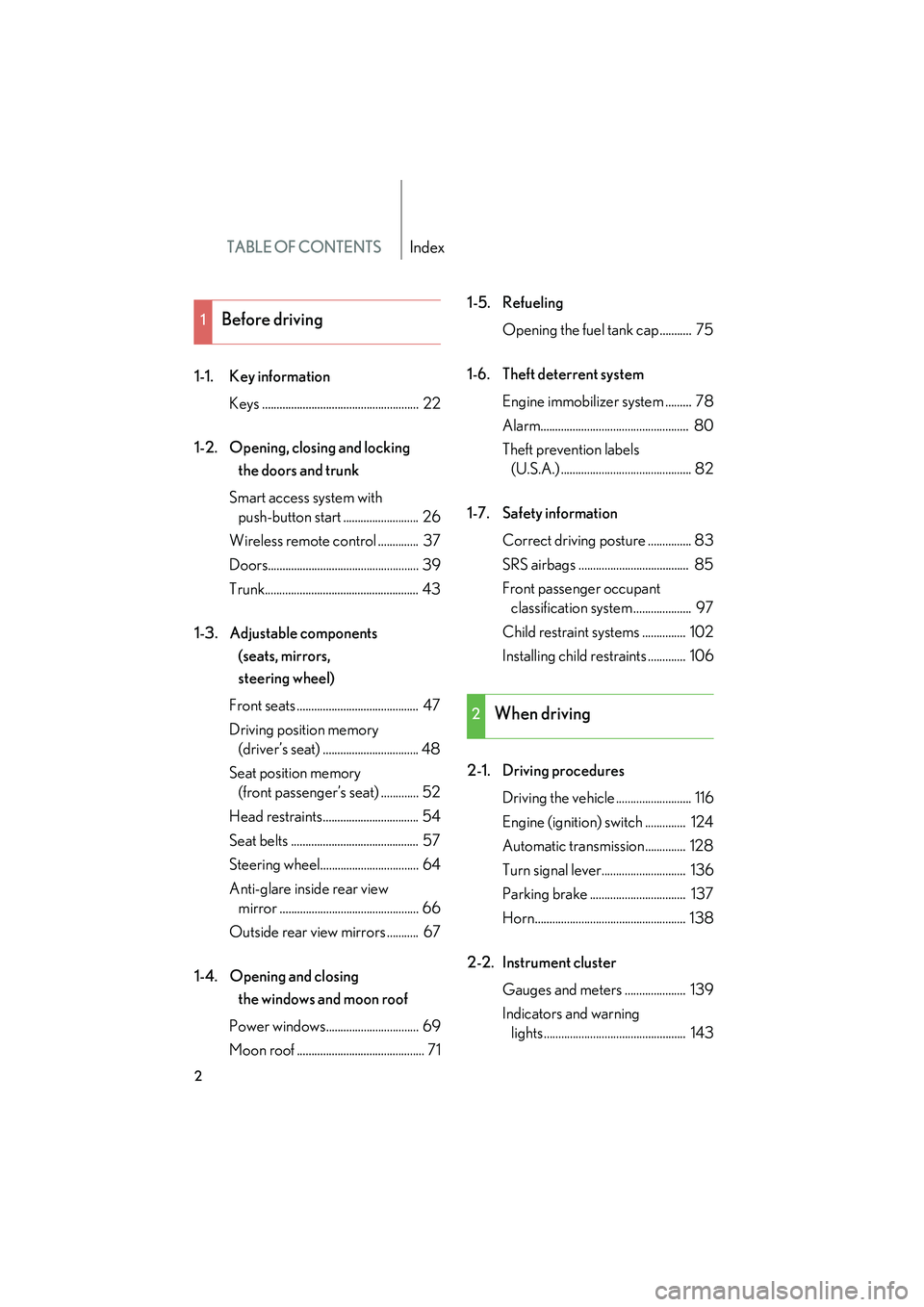
TABLE OF CONTENTSIndex
10_IS F_U
2
1-1. Key informationKeys ...................................................... 22
1-2. Opening, closing and locking the doors and trunk
Smart access system with push-button start .......................... 26
Wireless remote control .............. 37
Doors.................................................... 39
Trunk..................................................... 43
1-3. Adjustable components (seats, mirrors,
steering wheel)
Front seats .......................................... 47
Driving position memory (driver’s seat) ................................. 48
Seat position memory (front passenger’s seat) ............. 52
Head restraints................................. 54
Seat belts ............................................ 57
Steering wheel.................................. 64
Anti-glare inside rear view mirror ................................................ 66
Outside rear view mirrors ........... 67
1-4. Opening and closing the windows and moon roof
Power windows................................ 69
Moon roof ............................................ 71 1-5. Refueling
Opening the fuel tank cap........... 75
1-6. Theft deterrent system Engine immobilizer system ......... 78
Alarm................................................... 80
Theft prevention labels (U.S.A.) ............................................. 82
1-7. Safety information Correct driving posture ............... 83
SRS airbags ...................................... 85
Front passenger occupant classification system .................... 97
Child restraint systems ............... 102
Installing child restraints ............. 106
2-1. Driving procedures Driving the vehicle .......................... 116
Engine (ignition) switch .............. 124
Automatic transmission.............. 128
Turn signal lever............................. 136
Parking brake ................................. 137
Horn.................................................... 138
2-2. Instrument cluster Gauges and meters ..................... 139
Indicators and warning lights................................................. 143
1Before driving
2When driving
Page 9 of 542
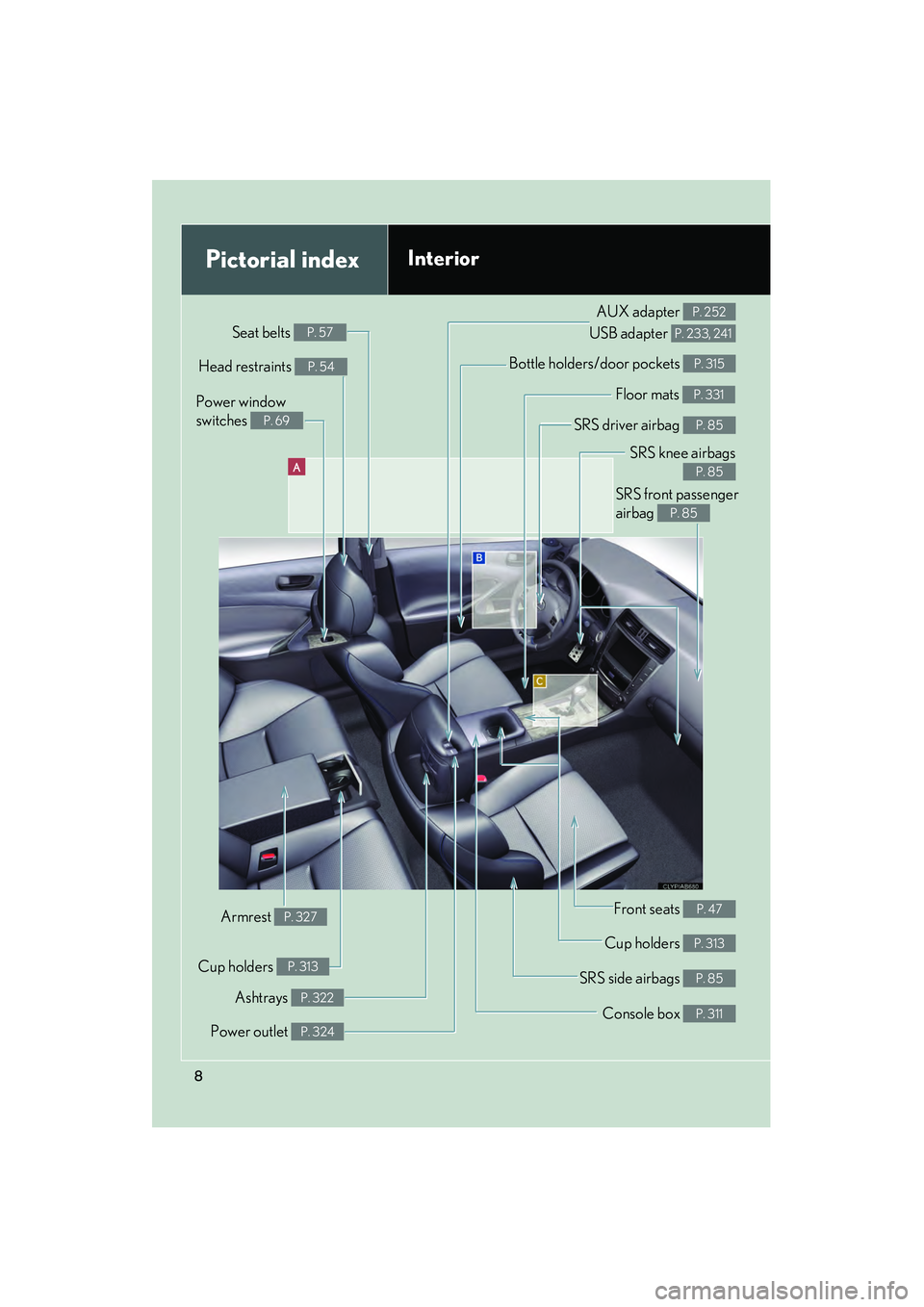
10_IS F_U
8
A
Power window
switches
P. 69
Pictorial indexInterior
Seat belts P. 57
SRS front passenger
airbag
P. 85
SRS knee airbags
P. 85
SRS driver airbag P. 85
Floor mats P. 331
Bottle holders/door pockets P. 315Head restraints P. 54
Front seats P. 47
Cup holders P. 313
SRS side airbags P. 85
Console box P. 311
Power outlet P. 324
Ashtrays P. 322
Armrest P. 327
AUX adapter
USB adapter P. 252
P. 233, 241
Cup holders P. 313
Page 10 of 542
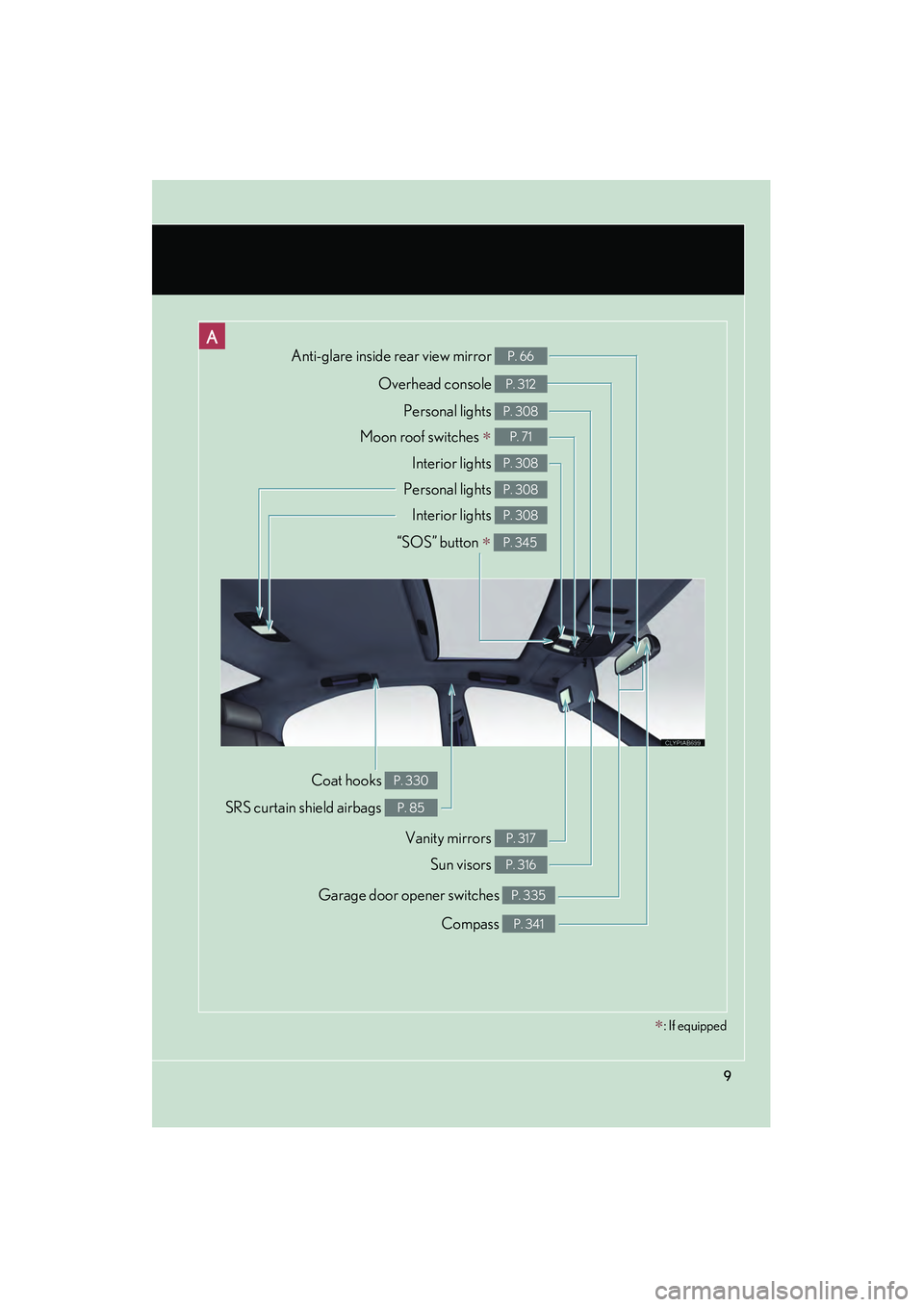
10_IS F_U
9
Compass P. 341
Garage door opener switches P. 335
Personal lights P. 308
Moon roof switches ∗ P. 71
Interior lights P. 308
Vanity mirrors P. 317
Personal lights P. 308
Interior lights P. 308
Sun visors P. 316
Coat hooks P. 330
SRS curtain shield airbags P. 85
A
∗: If equipped
Anti-glare inside rear view mirror P. 66
Overhead console P. 312
“SOS” button ∗ P. 345
Page 19 of 542
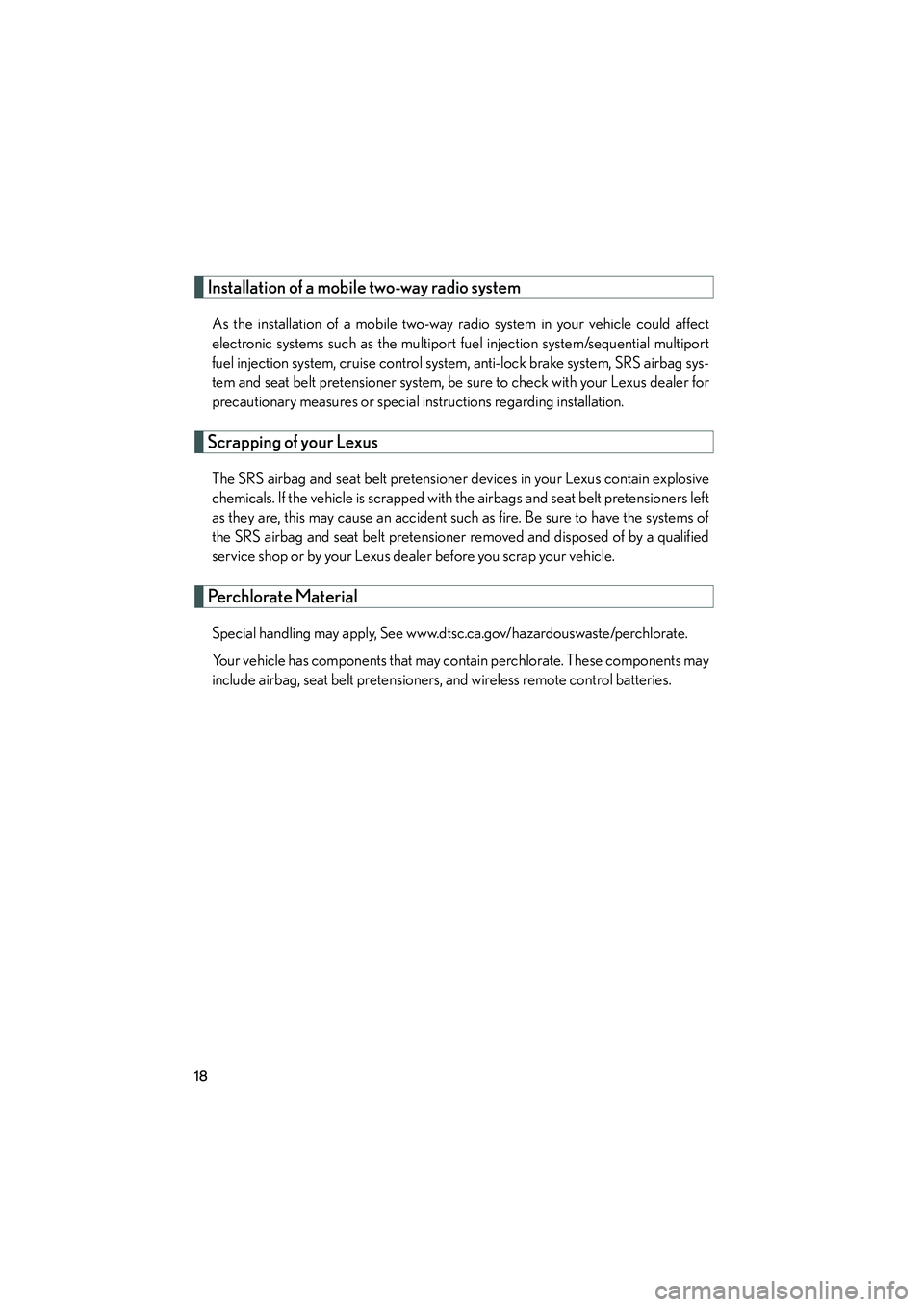
10_IS F_U
18
Installation of a mobile two-way radio system
As the installation of a mobile two-way radio system in your vehicle could affect
electronic systems such as the multiport fuel injection system/sequential multiport
fuel injection system, cruise control system, anti-lock brake system, SRS airbag sys-
tem and seat belt pretensioner system, be sure to check with your Lexus dealer for
precautionary measures or special instructions regarding installation.
Scrapping of your Lexus
The SRS airbag and seat belt pretensioner devices in your Lexus contain explosive
chemicals. If the vehicle is scrapped with the airbags and seat belt pretensioners left
as they are, this may cause an accident such as fire. Be sure to have the systems of
the SRS airbag and seat belt pretensioner removed and disposed of by a qualified
service shop or by your Lexus dealer before you scrap your vehicle.
Perchlorate Material
Special handling may apply, See www.dtsc.ca.gov/hazardouswaste/perchlorate.
Your vehicle has components that may contain perchlorate. These components may
include airbag, seat belt pretensioners, and wireless remote control batteries.
Page 22 of 542
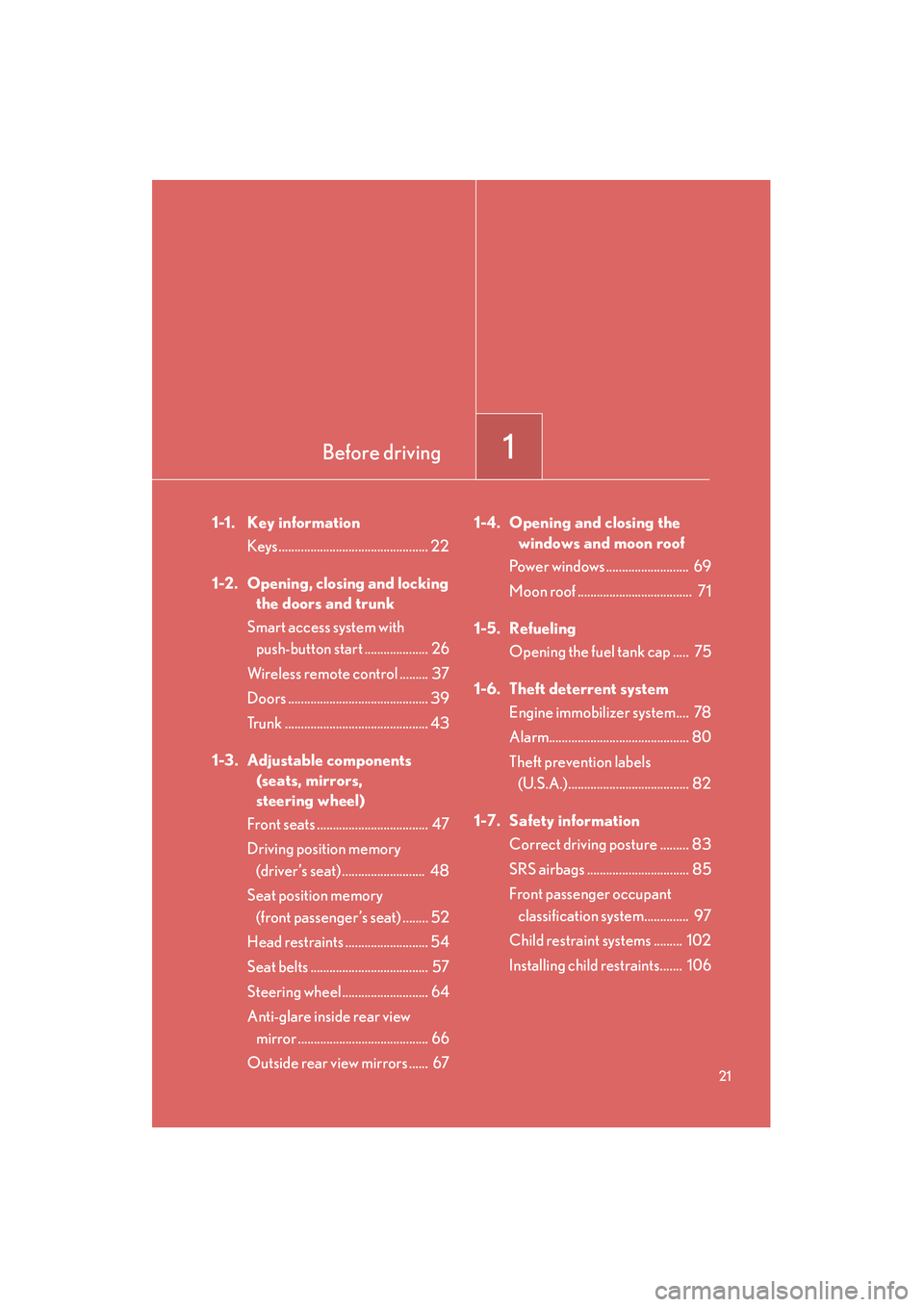
Before driving1
21
10_IS F_U
1-1. Key informationKeys ............................................... 22
1-2. Opening, closing and locking the doors and trunk
Smart access system with push-button start .................... 26
Wireless remote control ......... 37
Doors ............................................ 39
Trunk ............................................. 43
1-3. Adjustable components (seats, mirrors,
steering wheel)
Front seats ................................... 47
Driving position memory (driver’s seat) .......................... 48
Seat position memory (front passenger’s seat) ........ 52
Head restraints .......................... 54
Seat belts ..................................... 57
Steering wheel........................... 64
Anti-glare inside rear view mirror ......................................... 66
Outside rear view mirrors ...... 67 1-4. Opening and closing the
windows and moon roof
Power windows .......................... 69
Moon roof .................................... 71
1-5. Refueling Opening the fuel tank cap ..... 75
1-6. Theft deterrent system Engine immobilizer system.... 78
Alarm............................................ 80
Theft prevention labels (U.S.A.)...................................... 82
1-7. Safety information Correct driving posture ......... 83
SRS airbags ................................ 85
Front passenger occupant classification system.............. 97
Child restraint systems ......... 102
Installing child restraints....... 106
Page 84 of 542

83
1
Before driving
10_IS F_U
1-7. Safety information
Correct driving posture
Drive in a good posture as follows:
Sit upright and well back in
the seat. (→P. 4 7 )
Adjust the position of the seat
forward or backward to
ensure the pedals can be
reached and easily
depressed to the extent
required. ( →P. 4 7 )
Adjust the seatback so that
the controls are easily opera-
ble.
Adjust the tilt and telescopic
positions of the steering
wheel downward so the
airbag is facing your chest.
(→ P. 6 4 )
Lock the head restraint in
place with the center of the
head restraint closest to the
top of your ears. ( →P. 54)
Wear the seat belt correctly.
(→ P. 5 7 )
Page 86 of 542
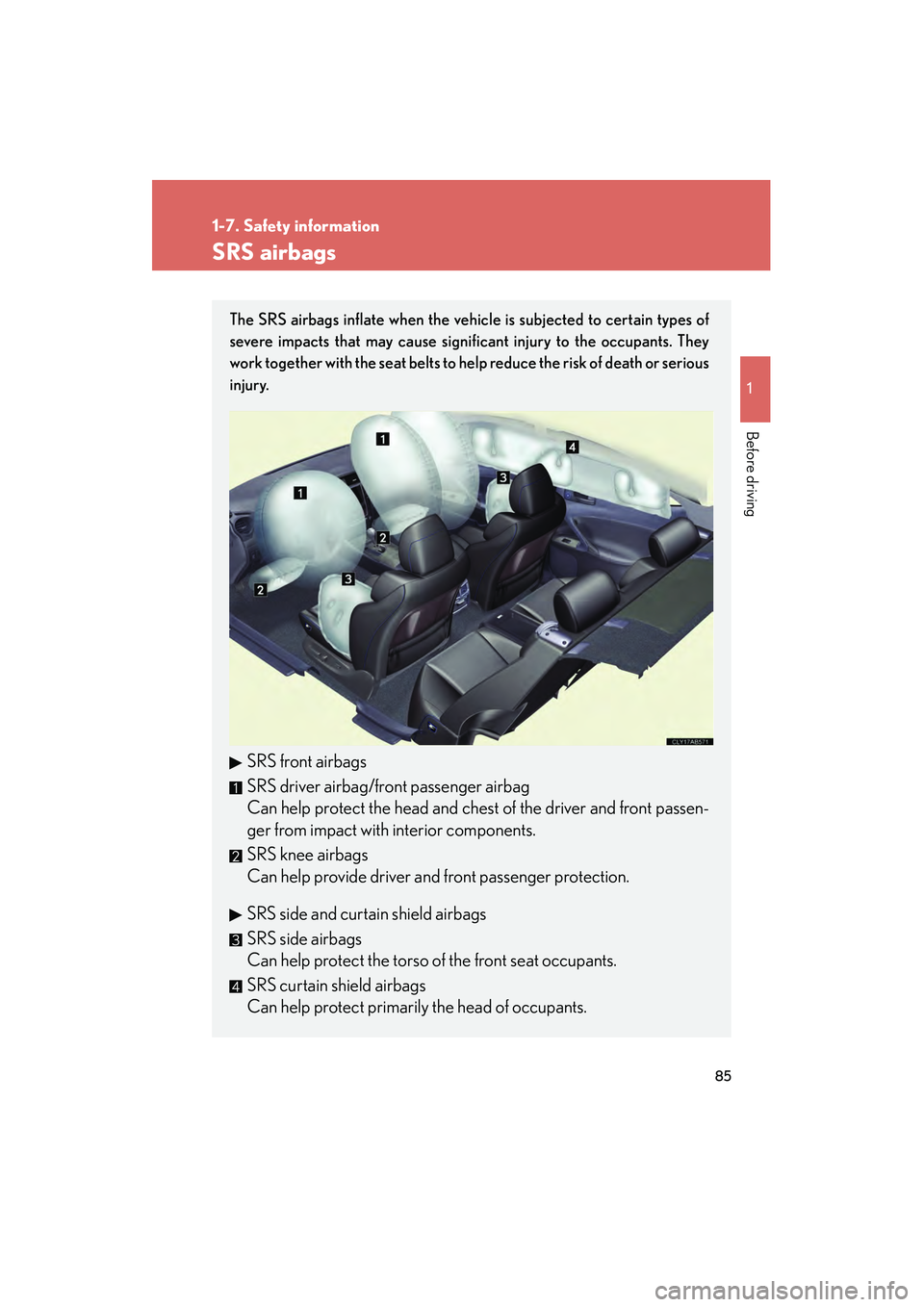
85
1
1-7. Safety information
Before driving
10_IS F_U
SRS airbags
The SRS airbags inflate when the vehicle is subjected to certain types of
severe impacts that may cause significant injury to the occupants. They
work together with the seat belts to help reduce the risk of death or serious
injury.
SRS front airbags
SRS driver airbag/front passenger airbag
Can help protect the head and chest of the driver and front passen-
ger from impact with interior components.
SRS knee airbags
Can help provide driver and front passenger protection.
SRS side and curtain shield airbags
SRS side airbags
Can help protect the torso of the front seat occupants.
SRS curtain shield airbags
Can help protect primarily the head of occupants.
Page 87 of 542
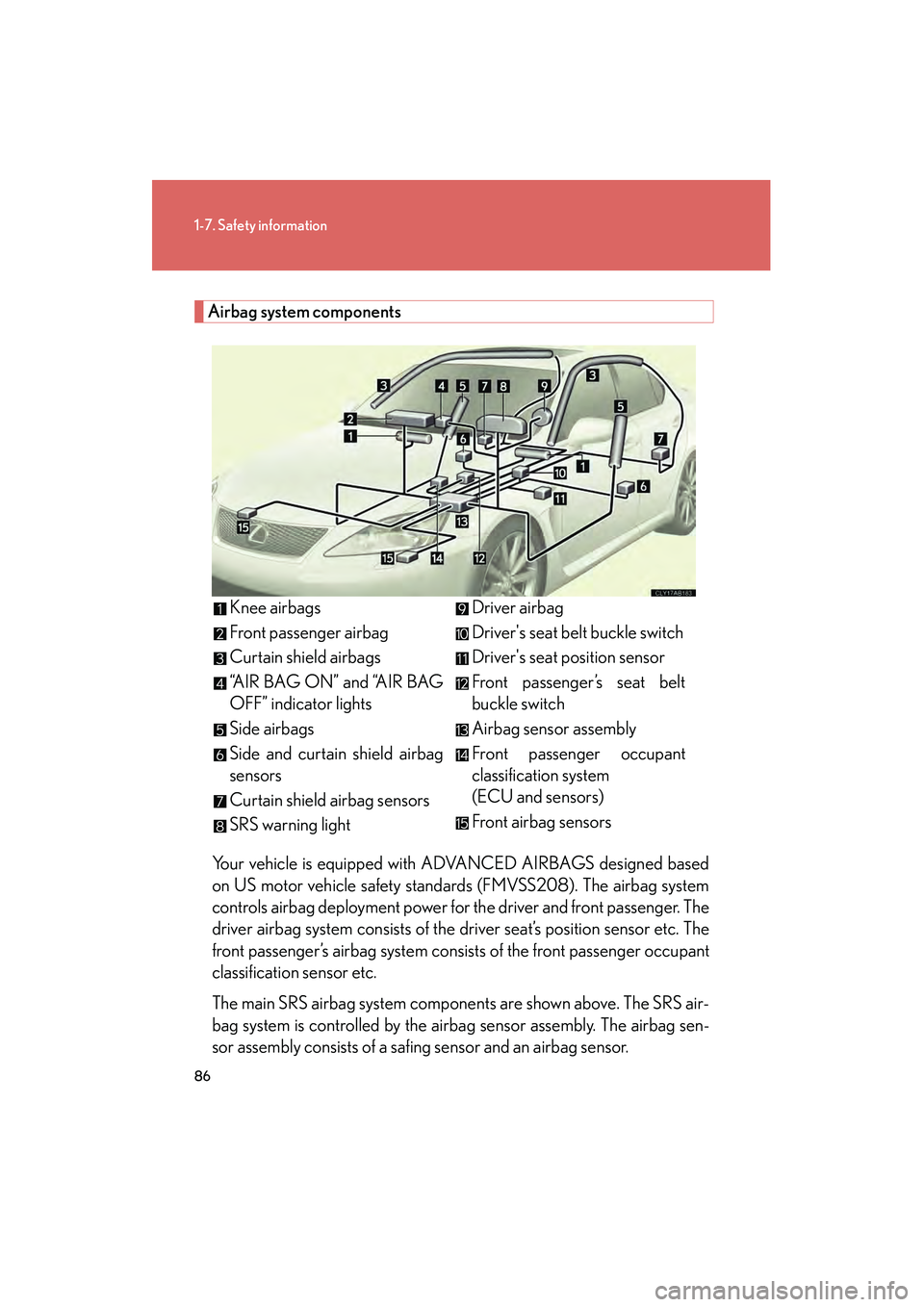
86
1-7. Safety information
10_IS F_U
Airbag system componentsYour vehicle is equipped with ADVANCED AIRBAGS designed based
on US motor vehicle safety standards (FMVSS208). The airbag system
controls airbag deployment power for the driver and front passenger. The
driver airbag system consists of the driver seat’s position sensor etc. The
front passenger’s airbag system consists of the front passenger occupant
classification sensor etc.
The main SRS airbag system components are shown above. The SRS air-
bag system is controlled by the airbag sensor assembly. The airbag sen-
sor assembly consists of a safing sensor and an airbag sensor. Knee airbags
Front passenger airbag
Curtain shield airbags
“A I R B A G O N ” a n d “A I R B A G
OFF” indicator lights
Side airbags
Side and curtain shield airbag
sensors
Curtain shield airbag sensors
SRS warning light
Driver airbag
Driver's seat belt buckle switch
Driver's seat position sensor
Front passenger’s seat belt
buckle switch
Airbag sensor assembly
Front passenger occupant
classification system
(ECU and sensors)
Front airbag sensors
Page 88 of 542

87
1-7. Safety information
1
Before driving
10_IS F_UIn certain types of severe frontal or side impacts, the SRS airbag system
triggers the airbag inflators. A chemical reaction in the inflators quickly
fills the airbags with non-toxic gas to help restrain the motion of the occu-
pants.
■SRS warning light
This warning light system monitors the airbag sensor assembly, front airbag sensors,
side and curtain shield airbag sensor assemblies, curtain shield airbag sensor
assemblies, driver's seat position sensor, driver's seat belt buckle switch, seat belt
pretensioner assemblies, inflators, interconnecting wiring and power sources.
(
→ P. 4 4 2 )
■If the SRS airbags deploy (inflate)
●Bruising and slight abrasions may result from contact with a deploying (inflating)
SRS airbag.
●A loud noise and white powder will be emitted.
●Parts of the airbag module (steering wheel, airbag cover and inflator) as well as
the front seats, and parts of the front pillar, rear pillar and roof side rail, may be
hot for several minutes. The airbag itself may also be hot.
●The windshield may crack.
●For Safety Connect subscribers, if the SRS airbags deploy or in the event of a
severe rear-end collision, the system is designed to send an emergency call to
the response center, notifying them of the vehicle’s location (without needing to
push the “SOS” button) and an agent will attempt to speak with the occupants
to ascertain the level of emergency and assistance required. If the occupants
are unable to communicate, the agent automatically treats the call as an emer-
gency and helps to dispatch the necessary emergency services. ( →P. 3 4 5 )
Page 89 of 542

88
1-7. Safety information
10_IS F_U
■SRS airbag deployment conditions (front airbags)
●The front SRS airbags will deploy in the event of an impact that exceeds the
set threshold level (the level of force corresponding to an approximately 12 -
18 mph [20 - 30 km/h] frontal collision with a fixed wall that does not move or
deform).
However, this threshold velocity will be considerably higher if the vehicle strikes
an object, such as a parked vehicle or sign pole, which can move or deform on
impact, or if the vehicle is involved in an underride collision (e.g. a collision in
which the front of the vehicle “underrides”, or goes under, the bed of a truck, etc.).
●It is possible that in some collisions where the forward deceleration of the vehi-
cle is very close to the designed threshold level, the SRS front airbags and the
seat belt pretensioners may not activate together.
●The SRS front passenger airbag will not activate if there is no passenger sitting
in the front passenger seat. However, the front passenger airbag may deploy if
luggage is put in the seat, or the seat belt is fastened, even if the seat is unoccu-
pied. (→P. 9 7 )
■SRS airbag deployment conditions (side and curtain shield airbags)
●The SRS side airbags and SRS curtain shield airbags will deploy in the event of
an impact that exceeds the set threshold level (the level of force corresponding
to the impact force produced by an approximately 3300 lb. [1500 kg] vehicle
colliding with the vehicle cabin from a direction perpendicular to the vehicle
orientation at an approximately speed of 12 - 18 mph [20 - 30 km/h]).
●The SRS side airbag on the passenger seat will not activate if there is no passen-
ger sitting in the front passenger seat. However, the side airbag on the passen-
ger seat may deploy if luggage is put in the seat, even if the seat is unoccupied.
( → P. 9 7 )